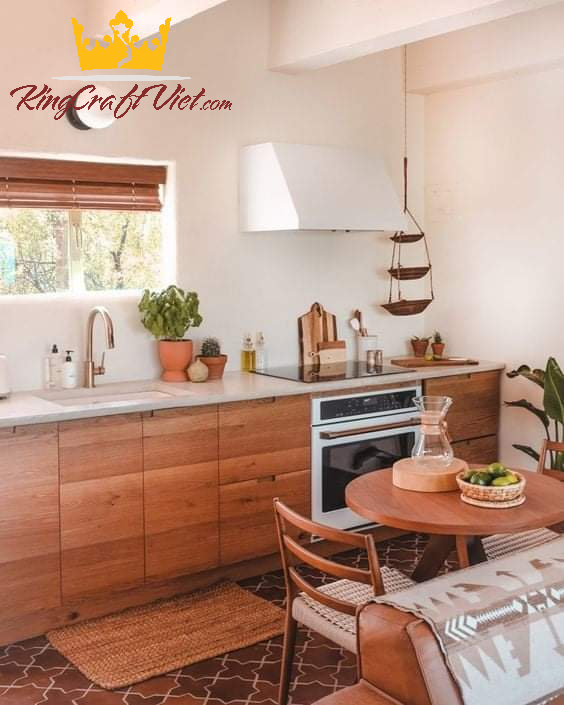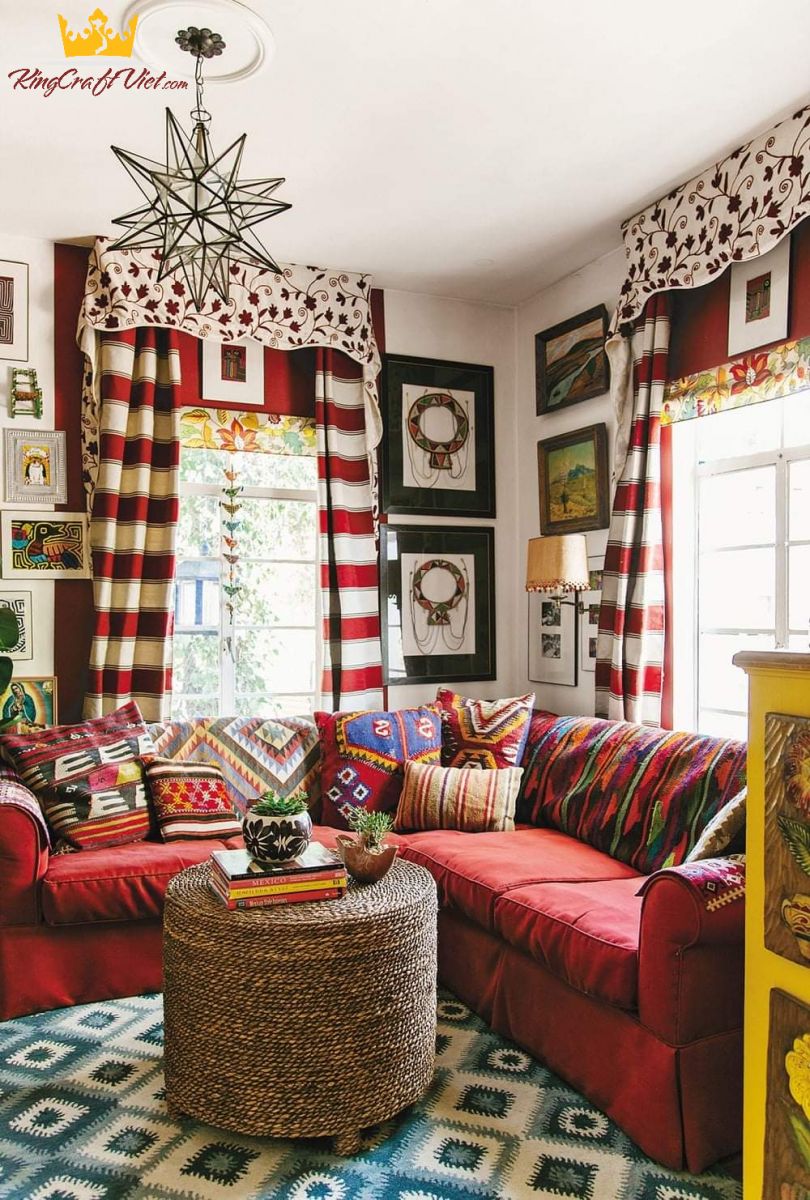The Importance Of Handicrafts In Vietnam
Thousands of years ago, Vietnam's handicrafts were created and produced. Bamboo and rattan handicrafts have a certain foothold in the consumer market, despite several ups and downs in the production process..jpg) Bamboo is a tree that all Vietnamese people are familiar with. Bamboo has been used in agriculture as household items such as benches, fans, tables, and so on since ancient times. There was a period when people preferred modern products, but as time passed, people realized the value of traditional goods. Since they are made entirely of natural materials and are also environmentally friendly.
Bamboo is a tree that all Vietnamese people are familiar with. Bamboo has been used in agriculture as household items such as benches, fans, tables, and so on since ancient times. There was a period when people preferred modern products, but as time passed, people realized the value of traditional goods. Since they are made entirely of natural materials and are also environmentally friendly.
Vietnam is a Southeast Asian country known for its tenacious bamboo. As a result, the government is supporting the rattan and bamboo export industry in order to revitalize the conventional industry. Currently, Vietnam exports these handicrafts to nearly every country in the world, earning praise from friends all over the world.
The Chance For Vietnam Handicrafts
1. SHARES IN THE MARKET
Meanwhile, rattan and bamboo products from Vietnam continue to have a small market share. According to Trademap 2019 figures, Vietnam currently has just around 3.37 percent of the global market share. As a result, rattan, bamboo, seagrass, and water hyacinth products still have a lot of potential for export development. In addition to main markets such as the United States and Japan, there are an increasing number of emerging markets, such as the United Kingdom (up 138.47 percent ), Western Spain (up 160.52 percent ), France (up 37.47 percent ), India (up 682.3 percent ), Russia (up 343.74 percent ), Australia (up 24.66 percent )...
2. POTENTIAL MARKET
More than 1,000 rattan and bamboo handicraft villages exist in Vietnam today, accounting for 24 percent of the country's total villages. Until now, Vietnam has exported rattan and bamboo products to 130 countries and territories, with an estimated annual export turnover of more than US $ 200 million, accounting for roughly 14% of total fine handicraft export turnover.
The US industry, in particular, is leading with over 19 percent market share, while Japan accounts for nearly 17 percent. However, the export turnover of Vietnam's rattan and bamboo craft industry is currently less than 3% of the global economy.
Retired people in Europe have more time to care for their homes. As a result, there is a growing market for decorative handicrafts. On the occasion of festivals, marriages, etc., they have a trend of going shopping for presents, souvenirs, and handicraft products. Market demand for handicraft goods is also affected by Christmas and New Year.
What is the significance of bamboo and rattan handicrafts, especially in Vietnam?
1.ECONOMIC AFFECTION
Currently, there are 723/2,017 villages manufacturing handicrafts in the year 2019. There are also over a thousand businesses engaged in producing and exporting handicrafts, recruiting 342 thousand jobs. Our country consumes between 400 and 500 million bamboos per year, as well as 600 to 800 tons of rattan and raw materials for consumer goods and export.
The export of rattan and bamboo products helps to alleviate the country's foreign exchange problems. Handicraft manufacturing, on the other hand, necessitates a significant initial investment. As a result, it will help businesses solve their capital shortage.
This industry not only adds to the value of exports, but it also employs rural residents and ethnic minorities. Handicrafts provide more employment, raise wages, and improve people's lives in rural areas. Handicraft artisans are expected to earn at least 3 million dollars a month, according to statistics.
The handicrafts industry has provided people with a steady source of income. Rattan was listed as one of the major tree species in the export by the Ministry of Agriculture and Rural Development.
2. SOCIETY
The rattan and bamboo industries in Vietnam are closely linked to the lives of people in rural areas and ethnic minorities. More than a million people live in families who make a living from this sector.
On the other hand, by producing and exporting handicraft goods, many countries around the world can gain a deeper understanding of Vietnam's people and culture. It aids the country's rapid integration with the cultures of other countries around the world.
As a result, the export of handicrafts is a pressing concern because it generates significant revenue for the country. Since it is made from locally available materials such as rattan, bamboo, seagrass, and water hyacinth, it aids in the resolution of social issues in the region.
The handicraft industry not only adds to the export value, but it also generates many jobs and improves the lives of employees. It also maintains and promotes the elegance of the Vietnamese nation's long-standing cultural values.
The rattan and bamboo handicrafts industry in Vietnam faces a number of challenges.
1. ISSUE OF RAW MATERIAL:
While the potential is great, the availability of input materials is a challenge for craft villages and businesses. Mr. Nguyen Hong Phong, Deputy Director of the local Department of Industry and Trade (Ministry of Industry and Trade), said that in the past, people could get natural rattan and bamboo if they just went to the forest, and that the price of raw materials was not high at the time. The cost of raw materials has risen dramatically in recent years. This is a major obstacle and a significant challenge for communities that produce handicrafts.
In addition to ensuring an adequate supply of raw materials, when the Free Trade Agreement (FTA) is signed, tariff barriers are eliminated, and export taxes are abolished, giving the handicraft industry an opportunity to increase product quality. Enterprises, in particular, must face the technological obstacles that countries erect.
However, the majority of rattan and bamboo businesses are still in the early stages of growth. Over 80% of manufacturing facilities lack sufficient resources to invest in technological advancement and production scale expansion. As a result, the majority of them depend on obsolete technology, machinery, low labor productivity, and poor product quality. Furthermore, the product lacks a range of versions, which limits the product's competitiveness.
2. LONG-TERM SOLUTIONS
Meanwhile, for the past few years, the key source of raw materials for rattan and bamboo export has been small-scale, low-volume, and sometimes fluctuating roads, resulting in long delivery times. The quantity and quality of raw materials have a significant impact on the execution of large orders.
It is important to work closely with craft villages, citizens, companies, and state management agencies to grow the rattan and bamboo rattan industries in a sustainable manner. They must devise holistic solutions, such as material preparation, processing center construction, raw material preservation, and product design renewal.
Experts say the land use plan needs to be revised and adjusted. As a result, unique land clearance plans will be developed to support units that need production ground... Simultaneously, it is important to improve vocational training, establish a team of artisans, and assist businesses in developing concentrated raw material areas in order to provide sufficiently stable materials for production.
-----------------------------------------------------------------------------------
KINGCRAFTVIET.COM- VIETNAM'S HANDICRAFT WORLD
Add: 41/49 Huynh Thuc Khang Street, Dongda Dist, Hanoi, Vietnam
Mobile (Whatsapp/Viber): +84 966420187
Email: sales@kingcraftviet.com

.jpg)





 config
config view
view logs
logs 14592.0 KB
14592.0 KB 159 ms
159 ms 16
16



